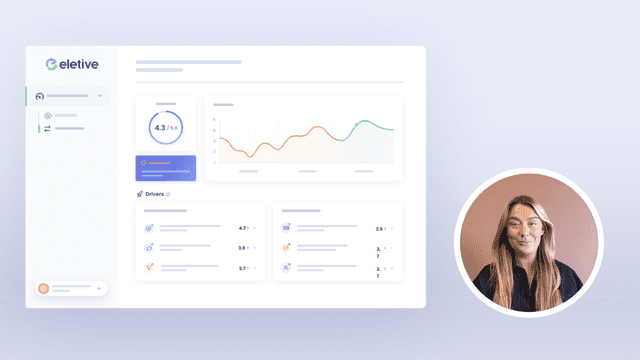What are the best employee engagement survey questions you can use to get feedback from your employees and measure the level of employee engagement in your organization?
By the end of this article, you'll be well-equipped to conduct a successful survey. So you can better understand and improve your employees' engagement levels.
What is an employee engagement survey?
An employee engagement survey is like a compass that helps organisations figure out how happy and committed their employees are.
These surveys are like mini-interviews that ask employees for their thoughts on things like office culture, how well their boss is doing, and how easy it is to talk to people at work.
By listening to what the employees have to say and taking action based on their feedback, companies can create a team of happy and engaged workers.
The importance of employee engagement surveys
Research shows that organisations with high levels of employee engagement experience increased productivity, higher retention rates, improved customer satisfaction scores and better overall business performance.
Conducting regular employee engagement surveys allows companies to:
Gauge the overall health of their organisation's culture
Identify potential issues before they escalate into bigger problems
Create targeted action plans based on data-driven insights.
Demonstrate that senior leaders value employee feedback and are committed to continuous improvement.
Provide real time feedback on specific topics or initiatives throughout the year.
The drivers behind employee engagement
To know what questions to ask in your employee engagement survey, you must first get familiar with the drivers behind employee engagement.
At Eletive, we work with 11 different areas of employee engagement that together form the basis for our employee engagement index. These drivers were chosen because of how closely they are related to the success of an organisation and healthy company culture.
Are you interested in reading more about the 11 drivers – and the research behind them? Download the Eletive Scientific Foundation.
Feedback and Communication: How employees share information about important areas such as, performance, work progress, resources, obstacles, and solutions.
Autonomy: Employees’ perception of the possibility to influence various aspects of their work and work environment. E.g. opportunity to adjust the work pace.
Meaningfulness and Participation: The feeling that you’re taking part in something valuable and important. I.e. performing a job that really matters. Also the sense of being respected and well-treated by colleagues and managers.
Workload: Demands placed on the employee and the control they have over those demands
Health: Focuses on three major underpinnings of maintaining good physical and mental health: food, sleep, and exercise
Workplace and Tools: Whether workers have adequate resources, such as tools and methods. Or if the resources are insufficient
Learning and Development: Highlights the employees’ opinions regarding possibilities for professional and personal growth
Goals and Goal Achievement: Goal setting, the definition of goals, as well as the actions taken to reach goals
Strategy, Vision, and Culture: How well employees have understood the core purpose and the fundamentals of why the organisation exists.
Relationship with Manager: including the managers’ ability to give support and create trust
Relationships with Colleagues: Communication, support, trust and conflict management are highlighted here
Employee engagement surveys: best practices
1. Use real-time pulse surveys to measure employee engagement
Historically, many companies measure employee engagement with one big, yearly survey. The problem with this approach is that it only gives a snapshot of the state of things at that particular moment in time.
The only thing constant in a business is change.
What you really need is an agile and flexible way to measure things. So you can track your progress and compare your employee engagement data to internal and external benchmarks. Eletive’s Employee pulse surveys will provide you with that continuously updated overview.
2. Decide on follow-up routines and stick to them
Discuss with your leaders before the first employee engagement survey is launched, and decide on follow-up routines.
It’s important that everybody knows what to do when the employee engagement survey goes live.
How often will you send the pulse survey?
How – and how often – will you follow up on the results with the team?
Communicate this beforehand.
3. Use open-ended questions
To understand what matters most to your employees, we always recommend that you add an open-ended text question at the beginning when you create a survey.
This way you can get valuable information from your employees that cannot be covered with a standardised question battery.
4. Measure eNPS (Employee net promoter score)
To get an overview of the overall level of employee satisfaction in your organisation, it's good practice to also measure eNPS, which is short for Employee Net Promoter Score. This is done with one single question that can be added to your surveys:
"How likely is it that you would recommend your employer to a friend or acquaintance?"
The answer options range from 0 to 10, where 10 means “Extremely likely” and 0 means “Not at all likely”. The responses are then divided into Promoters (9, 10), Passives (7,8), and Detractors (0-6).
5. Set the expectations and communicate them to everyone
Make sure everyone in the organisation knows the purpose of the employee engagement surveys, how they benefit from them, and what is expected from their side. Below are examples of what can be communicated in advance.
Managers are key players in the process and need to:
Have easy access to their team’s pulse survey results
Regularly discuss and follow up on survey results with their team
Develop and implement action plans together with their teams
Communicate regular progress updates to team members and management
Team members are also expected to play an active role and:
Take part in the follow-up meetings and contribute to the discussion
Keep track of their own engagement curve and think about how it can be improved
Show self-leadership and take ownership of issues that lie within their control
Turn to their manager for support when needed
6. Empower self-leadership and create a culture of accountability
Too often, the survey results tend to become “a problem for HR to solve” while the rest of the organisation sits back and waits for solutions. This is a dynamic the Eletive helps you avoid by involving not only managers but also employees in taking ownership of and responsibility for building a better workplace.
7. Ensure there’s a feedback loop in place from the start
Many organisations have made the classic mistake of launching an anonymous employee engagement survey without any feedback loop built into the tool they use.
What happens then is that you may end up with sensitive and possibly alarming information – but there is no way for you to dig deeper and investigate.
An example could be a comment about sexual harassment. Since you do not know who made it, it can be difficult to act on the information.
💡 Eletive solves this problem with an anonymous chat and a whistleblowing channel where employees can chat with leaders without showing their identity. This is a powerful tool for creating an organisation where everyone feels safe. Read more about the whistleblowing channel >>
8. Integrate your surveys with your tech stack to increase employee survey participation
By integrating your survey tool with the calendars and communication apps you use, your employees will get reminded to answer the survey inside the apps where they spend most of their time. This has a dramatic effect on response rates.
9. Customise your employee surveys to suit your brand and tone of voice
Employee surveys should be seen as a part of your whole employee communication strategy. By branding them with a powerful logo and brand colours, and by adjusting notifications, invitations, and sometimes also questions to your brand's Tone of Voice, the surveys can help reinforce your brand internally.
10. Complement employee engagement surveys with performance management programs
One-on-one meetings, regular check-ins, and performance reviews are all important – both to drive engagement and performance. They help managers understand each individual’s needs, challenges, and potential, and enable them to support their employee’s goals.
Many companies lack a formal structure for these interactions and a common place to save the data related to them. This can result in unfair reviews, and processes that differ widely across the organisation.
💡 Eletive entails a complete infrastructure for performance measurement. By bringing 1:1s, action plans, 360 feedback surveys, and OKRs into the same platform, companies gain a better overview and alignment and can work together to improve results.
Employee Engagement Survey Questions
Now that you know the drivers behind employee engagement and the best practices for surveys… let’s look at the same sample questions.
In order to effectively measure employee engagement, it is crucial to ask the right questions.
Job satisfaction questions – example questions
1. How satisfied are you with your work schedule?
2. Do you feel that your workload is manageable?
3. How much do you feel your job is contributing to the organisation?
4. How much do you feel appreciated for your work?
5. Do you feel that your job is fulfilling?
Management effectiveness – example questions
1. How well do your managers communicate with you?
2. How well do your managers support your career development?
3. How do your managers recognize and reward good performance?
4. How much confidence do you have in your managers' leadership abilities?
5. How effectively do your managers handle conflicts within the team?
Team dynamics – example questions
1. How well do team members communicate with each other?
2. How often do team members collaborate on projects?
3. How diverse and inclusive do you feel your team is?
4. How supportive is your team of each other?
5. How well do team members share knowledge and information with each other?
Company culture - example questions
1. How well do you feel the company's mission and values align with your personal values?
2. How committed is the company to social responsibility and sustainability?
3. How much does the company prioritise employee well-being and work-life balance?
4. How much does the company encourage creativity and innovation?
5. How well does the company foster a sense of community and belonging among employees?
Employee development - example questions
1. How much support do you receive for your professional development and growth?
2. How often do you receive training opportunities that are relevant to your job?
3. How much do you feel your skills and knowledge are being utilised in your current role?
4. How much do you feel your job is preparing you for future roles within the organisation?
5. How much do you feel that your opinions and ideas are valued by the organisation?
Benefits and compensation – example questions
1. How satisfied are you with your current salary?
2. How competitive do you feel your benefits package is compared to other companies in the industry?
3. How much do you feel the company values and rewards good performance?
4. How much do you feel that your compensation reflects your level of experience and contributions to the organisation?
5. How well does the company provide financial planning and retirement benefits?
Employee training survey questions
1. How satisfied are you with the current training programs offered by the organisation?
2. How effective do you feel the training programs are in preparing you for your job?
3. How often do you receive training opportunities that are relevant to your career goals?
4. How well do you feel the training programs are customised to your learning style and needs?
5. How much do you feel the training programs are preparing you for future roles within the organisation?
💡 Good to know: You can easily analyse your open ended questions with Eletive’s listening AI feature.
How to answer employee engagement survey questions
1. Be honest and open
Be candid in your responses, expressing both the advantages and areas of potential improvement you have encountered.
Don't be afraid to share both positive experiences as well as areas where you think improvements could be made.
2. Provide specific examples
To give more context and clarity in your responses, try to provide specific examples when possible.
For instance, if you're answering a question about employee communication, mention instances where communication was effective or situations where it could have been better.
3. Focus on constructive feedback
Rather than simply pointing out problems or issues within the organisation, offer suggestions for improvement whenever possible.
Making an effort to cultivate a more positive atmosphere by offering potential solutions is indicative of your dedication.
Avoid using negative language: Instead of saying "The management team doesn't listen," try phrasing it like "I believe there's room for improvement in our management's ability to actively listen."
Suggest actionable steps: Offer concrete ideas on how things can be improved - e.g., "Regular town hall meetings might help bridge the gap between employees and leaders."
Note: Keep your responses anonymous
Employee engagement surveys are anonymous, so you can feel comfortable sharing your honest opinions without fear of repercussions. However, avoid providing personal information or mentioning specific names that could potentially identify you, so make sure to avoid that.
4. Take your time
Rushing through the survey might lead to incomplete or unclear answers. Set aside enough time to carefully read and consider each question before responding.
5. Reflect on your overall experience
In addition to focusing on specific aspects like leadership skills, training opportunities, and communication channels, take a moment to think about your overall experience as an employee at the company.
This holistic perspective will help provide more accurate feedback in the survey.
What to do with employee survey results
Once you have collected the data from your employee engagement survey, it's essential to analyse and act on the findings. Once the data is gathered from the employee engagement survey, this guide will assist in interpreting results, recognizing areas that need enhancement and putting into action changes based on responses.
2. Analyse the data
The first step in making sense of your survey results is analysing the data. Look for trends or patterns in responses that may indicate areas where employees are particularly engaged or disengaged. You can use tools like Eletive to help visualise and understand this information more easily.
3. Prioritise areas for improvement
After analysing the data, identify which aspects of your organisation need attention most urgently.
Focus on addressing issues that impact a large number of employees or those related to key drivers of engagement, such as leadership effectiveness, communication quality, and opportunities for growth.
Leadership: If leadership survey questions reveal concerns about management styles or decision-making processes, consider offering training programs aimed at improving these skills among managers.
Communication: Employee communication survey questions might uncover gaps in internal messaging channels and explore new ways to facilitate open dialogue within teams and across departments.
Growth opportunities: When employee performance survey questions highlight dissatisfaction with professional development options available within your company, look into expanding existing resources or creating new ones tailored specifically towards career advancement goals expressed by staff members during surveys.
4. Action planning: creating an implementation strategy
Create a detailed action plan outlining how you'll address identified problem areas over time - including specific steps needed along with deadlines and responsible parties for each task. This plan should be communicated to all employees, demonstrating your commitment to improving engagement and overall workplace satisfaction. You can use Eletive’s organisational action plans feature to do this.
5. Monitoring progress
As you implement changes based on survey feedback, it's crucial to track their impact over time. Regularly reassess employee engagement levels through follow-up surveys. By doing this, you can assess the efficacy of your changes and make any necessary modifications as needed.
Involving employees in the process
To foster a sense of ownership and buy-in from staff members regarding improvements made within your organisation, involve them in both decision-making processes related to addressing survey findings as well as ongoing monitoring efforts aimed at tracking progress towards goals set forth during action planning stages.
Once the survey outcomes have been acquired, it is essential to assess them and use them to create approaches for improving worker involvement. To ensure that you are getting accurate data from your surveys, consider researching vendors who specialise in providing reliable employee engagement surveys.
Best employee engagement survey vendors
Finding the right employee engagement survey vendor is crucial for obtaining accurate and actionable insights. Navigating the wide range of vendors to find the ideal fit can be daunting.
To help you make an informed decision, we've compiled a list of some of the top vendors in the industry:
Eletive
Glint
Peakon Workday
Culture Amp
When evaluating these vendors, consider factors such as ease-of-use, customization options, data analysis capabilities, and customer support.
We’re a bit biased, but in our opinion, Eletive is the best option. Here’s why…
Eletive is an employee engagement survey platform trusted by companies like Dole, Hertz, and Sats.
Our real-time pulse surveys and machine learning give you instant access to valuable insights to improve employee engagement, performance, and retention.
Our platform also offers tools for performance management and self-leadership, as well as flexible access management and integrations with other HR systems.
Conclusion
Employee engagement surveys are a powerful tool for HR professionals to boost job satisfaction, productivity, and retention.
By leveraging the latest technology and expert support from Eletive, you can take your organisation's employee engagement to new heights.
Interested to learn more? Book a demo today and join the ranks of some of the world's best places to work!
FAQ
How do surveys improve employee engagement?
Surveys help identify areas of improvement and provide insights into employees' needs, expectations, and satisfaction levels. By addressing these concerns proactively, organisations can create a positive work environment that fosters higher engagement and productivity. Moreover, conducting regular surveys demonstrates management's commitment to listening to employees and valuing their feedback.
Are employee engagement surveys effective?
Yes. When designed well and executed consistently with clear objectives in mind, surveys have proven effective at gauging workplace dynamics while providing actionable intelligence needed to drive improvements across various dimensions of organisational life leading ultimately towards better business outcomes including increased retention rates, reduced absenteeism, enhanced customer service delivery, among others.

























